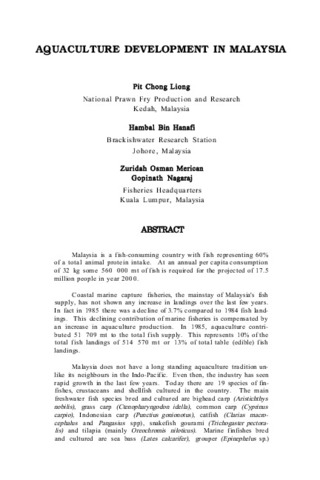Use of plant protein sources in aquafeed for high value marine species in ASEAN member states
- Global styles
- MLA
- Vancouver
- Elsevier - Harvard
- APA
- Help
Share
抄録
Cultured marine aquatic species are predominantly carnivorous. Major species in the region are seabass, grouper, snapper, tiger shrimp, mangrove crab and abalone. These species, except for abalone, require a high level of dietary protein mostly supplied by marine sources such as fish meal. Global production of marine fish and marine shrimps showed a 3-4 fold increase from 1995 to 2010. For the same period, the usage of commercial feed for production of marine fish and shrimps increased while the fish meal portion in the formulation decreased. This is indicative of fish meal being substituted with alternative sources in commercial feed production, and to some extent the substitution of marine oil which particularly improved the FCR for the marine fish production from 2.0 to 1.9 and for marine shrimps from 2.0 to 1.6.
Plant products that include cereal grains, legumes and oilseeds have the most potential among the alternative ingredients for use in aquafeed. The use of these resources for high value marine species is limited due to a variety of anti-nutritional substances they contain. Removal of these substances by processing techniques has improved utilization but with added cost. Hence, fish meal is still the primary source of protein for marine carnivores and its substitution with higher amounts of alternative plant proteins may be difficult compared with lower levels of replacements. The Asian region has accounted for the more than 50% of the total global aquaculture production in 2012 with indications of increased utilization of alternative protein sources in commercial feed production. For the major marine species in the region the increasing trend of plant protein usage with the targeted levels of substitution of fish meal with plant protein sources should be sustainable.
Suggested Citation
Catacutan, M. R. (2015). Use of plant protein sources in aquafeed for high value marine species in ASEAN member states. In M. R. Catacutan, R. M. Coloso, & B. O. Acosta (Eds.), Development and Use of Alternative Dietary Ingredients or Fish Meal Substitutes in Aquaculture Feed Formulation : Proceedings of the ASEAN Regional Technical Consultation on Development and Use of Alternative Dietary Ingredients or Fish Meal Substitutes in Aquaculture Feed Formulation, 9-11 December 2014, Nay Pyi Taw, Myanmar (pp. 89-96). Tigbauan, Iloilo, Philippines: Aquaculture Department, Southeast Asian Fisheries Development Center.
Type
Conference paperISBN
9789719931058
Related items
Showing items related by title, author, creator and subject.
-
Aquaculture development in Thailand
Sirikul, Boonsong; Luanprida, Somsak; Chaiyakam, Kanit; Sriprasert, Revadee (Aquaculture Department, Southeast Asian Fisheries Development Center, 1988)Aquaculture practised in Thailand is in the form of pond culture and cage culture in freshwater, brackishwater and coastal areas. The main species cultured include freshwater prawns, brackishwater shrimp, cockles, mussels, ... -
Aquaculture development in Malaysia
Liong, Pit Chong.; Hanafi, Hambal Bin.; Merican, Zuridah Osman.; Nagaraj, Gopinath. (Aquaculture Department, Southeast Asian Fisheries Development Center, 1988)Malaysia is a fish-consuming country with fish representing 60% of a total animal protein intake. At an annual per capita consumption of 32 kg some 560 000 mt of fish is required for the projected of 17.5 million people ... -
Management of feeding aquaculture species
Alava, Veronica R. (Aquaculture Department, Southeast Asian Fisheries Development Center, 2002)This chapter teaches the reader to: differentiate the different feeding strategies in pond culture; learn feeding management methods such as stock sampling and record keeping, calculating daily feed ration, choosing ...







